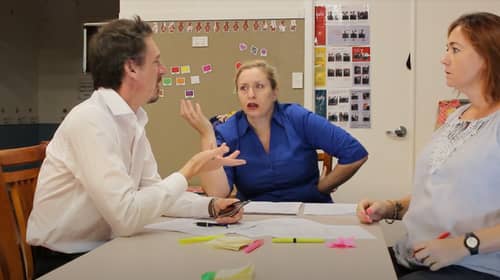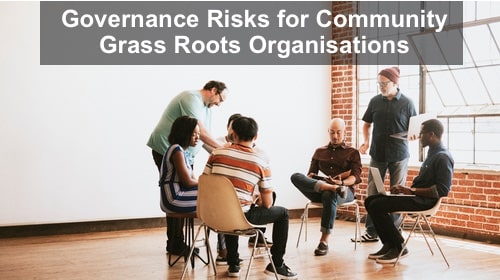Starting a Not-for-Profit
Thinking of launching a not-for-profit? We dive headfirst into the world of not-for-profits. Whether you’re a seasoned philanthropist or just starting out, we go through the steps to create a not-for-profit.
Authored by: Natalie Bramble
Video Transcript
Hello, everyone. Welcome to starting a not-for-profit. I’m Natalie Bramble, CEO and co-founder of Iclick2learn and Your Not-for-Profit guide. And today we’ve got a very exciting topic where we’re going to be exploring, in a short amount of time. Before we get started, I would like to firstly acknowledge the traditional owners of the lands that we’re meeting. I’m actually coming to you live from the lands of the Thubba-gah on Wilay Wiradjuri country in Dubbo, New South Wales. But we have, I think almost every state, with us today. There’s maybe a few missing, but, we’ve got quite a few, across different states with us today on different country.And those, of course, who are watching the recording. So welcome along. And, and I’d like to extend respect to Elders past, present and emerging and, and those that identify as Torres Strait Islander joining us today. I also wanna do a big shout out and acknowledgement to, to all of you and, and to those that are volunteering and working in community organizations and nonprofits and those that are in social enterprises or businesses that really are striving to improve, and make our, our communities a lot better and, and working towards a goal, whatever that goal may be. Because that’s often how not for profits can get started is is because of someone’s personal passion to make change. So we are gonna be exploring that today. In brief, there’s a we’ll be touching on a few topics, so some of them more briefly perhaps than others. I’ll see where the chat leads us.
That’s the value of joining us live for these is, is you certainly get to ask questions and, and, you know, some of that that information, the depth of information I cover depends on what people want to know as well. And for those joining us live, of course, you will get access to the recording. So you’ll be able to go back and pause and consider particularly as we get to some questions. So today I’m gonna be covering things like, you know, what are the questions that you need to actually consider before you start a not for profit. I’m going to be looking at, what legal requirements, obligations, what are some different incorporation models, directing you towards some fees and and what you need to consider there. We’ll be talking about tax and charitable status as well and, and, you know, things like your documents, your governing rules. So that’s what we’re going through, today. And again, as always, if you have any specific questions, feel free to drop those in chat as we go through.
If anything comes to mind, just ask away. Hi Nat, what about XX? So, I’ll address that. Before we begin looking at some of the, detail of that, there are a couple of key questions that we really need to sit with. If we’re thinking about starting a not for profit, if we have, someone come to us with an idea to start a not for profit. These are really 3 key things that I like to start with. There is, another key question that I’ll ask. You’ll see it in the list a little later, but it’s about the exit. So really the key ones that I ask is why? Why do you want to start a not for profit organization? What is the motivation? Now, I get a mixed range of questions, everything from, oh, well, we want to be able to apply for grants.
So, so you need to dig a little bit deeper. It’s not, it’s not about, oh, there are grants available, but we have to be a not for profit to apply for them. It’s like, not. Why do you profit start a not for profit? Let’s forget the funding aspect for a moment. Funding is really important. Of course, we’ll come to that a little later. So it’s really important to understand the motivation and particularly when it is personally driven. If it’s with a group of people that have come together and said, we want to start a not for profit, then what’s the common purpose? What is the common motivation that we’re working, towards all that we have in common? It’s really important to get that that, basically that group agreement, if you like about what is the motivation and desire to start this not for profit.
You know, it’ll it’s driven by need because we see a need, again, either as a group or as individual, we’re like, you know, we need this to happen in our community. So, you know, it is it is a matter of saying, okay. But is that a real need for is it a want? And and a real need, you should be able to demonstrate that. So if I said to you, how can you prove that there’s a need? And and often one of the ways, obviously, to prove that there’s a need is you go outside your friends, fans, and family, and you ask your community. So, just asking the 3 f’s, which are friends, family, and, and fans. And fans are just generally people that just love what you do. I think the, the traditional one, they use fools, but it’s not fools. It’s just fans.
So, be go beyond your circle and your network and ask, people. So for example, if there’s something you want to do with youth, well, ask youth you don’t know. Go and talk to a youth organization that you don’t know. So really explore that. Is there actually a need for something like this? Starting, a new enterprise, a new not for profit, a charity, social enterprise, you know, we’ll talk about structures in a little while, but starting anything new, of course, there is this mindset that will hang on a moment, that’s actually competing with other organizations. They may not be as open to know, having that conversation with you. But the thing, that I just really want to pause on and just reinforce is that starting a new organization is not necessarily the best alternative. And you’re gonna you’re going to sort of, see me share some some pieces of information, particularly if you’re an individually individual that’s motivated.
It’s not particularly the best, approach. Really, what we need to sit with is we need to sit with our our actually, other organizations who are doing something similar, that would be more appropriate to approach to see if they’re interested in collaborating. Now in some cases, they’re not. You know, they may see you as a a competitor. They may not be interested in in what you’re doing, or they may actually be interested in what you’re doing and wanna do it themselves. So, and in some cases, they’re not necessarily the right organization to be delivering what you’re proposing. But it is really important before you start something new that you do think about what are the alternatives. Not, if I use the lens of government.
So for those of you who don’t know, I am a, highly successful grant writer. I’ve got over 80% success. I work with a lot of different organizations. I help funders develop programs. I work with government. We we write, we assess, we do it basically across a whole spectrum of grants. And so this what I’m about to say comes from this body of knowledge is that that funders know there are far too many services and organizations that are duplicated. So, you know, I can think of one really small community that’s got 2 residents, associations.
So, you know, they know that there’s a lot of duplication and it, it is important for you to be aware of who else is out duplication and it, it is important for you to be aware of who else is out there doing similar things. Because one of the things that if you are going down the grant and funding path, one of the things that you actually need to prove is how are you different. So it is about that unique value. You may have heard that UVP or USP, the unique value that your organisation is going to offer that others don’t. And it may very well be that you’re gonna fill a gap, in an existing service system. And what I mean by system is you basically think about just write a list. Who is doing this? Get on Google. Have a look at community service, or community group, lists, and just just find out what are they doing and then work out, you know, have that discussion around how, is what you’re doing differently.
Beautiful. So they’re definitely questions to ask. The other one to ask is how are you going to exit, which I’ll come to that, that’s on the next series of questions. So I’ve kind of grouped these into a few things. This is the motivation, and this really comes back to that why question. Why do you wanna start it? But it is drilling a little bit deeper. It is about what is the purpose, and you will need to document this. You will need to actually write it down at some point.
When we you know, typically, when we get so excited about doing something, when we know that this is gonna have so much value, this is gonna be a fantastic, you know, result, an outcome that we’re providing benefits to community or elderly, whoever it is that we’re providing benefits to, whatever it is that we do, we know that it’s going to be amazing. It is so important to make sure when you’re going through this, that you have what what’s called a critical friend. And that’s the person that is able to take that independent lens and just quiz you on the things, you know, but why do you wanna do that? But why is it so important that it’s you? The older term for critical friend is a devil’s advocate. So they’re value really valuable people. It is important to have that person asking you those questions questions because you don’t want others you don’t wanna get all of this ready and then, someone else say, but why? And you don’t have that answer for them. So they can really help you think through. So you do need to be clear about the purpose. The other reason you need to be clear about that is when you get to looking at developing a constitution, what you’ll need to, basically provide your authorizing body.
And we’ll talk about those a little later because they’re different for each state and also, for the Commonwealth, if you’re looking at federal, legislation that you’ll incorporate under. So we will talk about those as well. You’ll actually need to be able to have a statement that you put in your constitution or that you put in the form that you submit. And the statement is objectives. So this is something that you must have. Your constitution has to have objectives. Objectives, in essence is what you, when it’s in your constitution, it’s what you are legally, defined to be delivering. So in some cases, for funders will ask you for copies of your constitution and they’ll actually have a look at your objectives and they will say, well, the project that they’re wanting to do for what they’re wanting to do actually doesn’t align to their objectives.
Objectives are exceptionally important when we get to the stage of deciding whether or not we actually want to be a charity and obtain not tax status, which is called deductible gift recipient status or DGR for short. And I’ll use the term DGR moving forward. If you forget what it is, just ask me in chat, but, deductible gift recipient. So objectives are really, really important. So that purpose, what you’re actually intending to do, and don’t be too specific about how. We’re not talking about the how right not, we’re talking about the purpose. The purpose obviously could align to the goal. What is your impact? Now impact is that really that long term benefit.
So I’m gonna give you an example. For those of you who are library members, if you wanna know a little bit more about theory of change and social impact, a colleague and I, one of our subject matter experts at Iclick2learn, Ali, Mudford, we actually produced a 2 part social impact course that you will find in the library. So just go to the library and search social impact, and you’ll find that. And it takes you through what a theory of change is and, and how to define social impact. So for those of you interested in that head there, for those of you starting off, you don’t need to just yet, but I do mention those things. Cause I know that some of us are at different levels. For example, I know Mary is supporting other organisation, so that will be helpful to know. So you really need to define what’s the difference that you want your not for profit to make.
It is really important to be really clear about that. What is the difference that you want to make? That’s called impact. So, what’s the goal? Then it’s about who will you support? So this is about defining rather than just saying, oh, we’re going to help everybody. We’re going to support everybody. It’s actually about defining what that target audience or target group is. What do they look like? And it could be, for example, really specifically, like, we need this group of people, like youth aged 12 to 16. It could be broader. It could describe their family situation.
It could describe their financial situation. So it is important to be a little clear about that. You know, we we start profit because we know there’s a need, and we’ve sometimes experienced that need ourselves and sometimes we see that there’s a need. So think about those groups of people, who have that need. What does that look like? It could be, you know, someone who’s recently being dies diagnosed with a rare disease, for example. So really being as specific as possible. This is certainly going to help you further down the track when you start to really look at, you know, what are you gonna call your organisation? Who are you gonna market to, etcetera? It also helps you when you start, looking for, financial support because you’re able to use that data and those statistics. And, and I won’t talk about grants in particular.
We have other courses, in the library that will help you with that as well. And a shout out to, to Linda. Great to see you join us, Linda. We are recording this session, so you’ll be able to go back and, and watch the the questions we have about before you begin your not for profit and where we’re up to now. So you then need to think about the how. Okay. If you’ve already set what your purpose is, what the difference you’re trying to make, who you’re you’re looking to support, you then should have some sort of idea about how you’re going to do that. Now that could be, for example, if it’s about building awareness about a particular social cause or social issue, it could be about, you’re going to be delivering awareness events and those awareness events will be either independent or they might actually be joined to other events.
So for example, your local show or or your volunteer week or seniors expo, whatever it might be. So it’s being about being very specific. In some cases, it’s actually about delivering programs or services. So, that could obviously be a fee for service or a subsidized program, or something that you’re wanting to find grant funds to pay for. So, again, be a little bit specific about, you know, what what does that look like? Guaranteed when we start something and we’re generally changes along the way. So you don’t have to be completely, wedded to this. You don’t don’t think, oh, no. That’s too soon.
You do need to start thinking about it. And the reason you need to start thinking about it, we have to kind of have a talk about how are we going to fund this new not for profit. Another question I always ask, particularly if it’s an individual that comes to me and says, I want to start a not for profit, or I want to start a charity or a social enterprise. The one question I ask them is, how will you exit? If you’re gonna start something, there’s gonna be a point where you need to move on. And that move on point, you know, might be, when you’re no longer on this earth for it might be when you win lotto and move overseas. I don’t, you know, I don’t know. So at some point you’re going to say, look, I’m actually, it’s time for me to move on, from this organization. And this is really important because profit have a high risk of failure if they depend on one person.
They also also have a high risk of failure if your exit strategy, and your succession isn’t planned well. So it is important to think about this first. I remember being asked this actually my first, business and I just call it Natalie Bramble Management. I had no idea. I just, you know, left work because of the glass ceiling. And then, and, got a contract and they said, you need a business name. I’m like, oh, okay. Right.
I’ll just do that. And, and someone said, how are you gonna sell it? You’ll have to, it’ll have to be NB Management and you’ll be Adelie Ramble then. So, you know, for me, it was like, that’s fine. I don’t want to sell it. It was all good. But, I have had people when I’ve asked this question about for, starting a not for profit, and I’ve said, how will you exit? And they and they’ve actually thought about it because, you know, it does take a little bit of time to really question. They’ve put a lot of time and energy into it, and sometimes they’ve come back and said, well, I wanna sell it actually. So that tells me right away that a not profit model’s not going to work because you can’t sell a not for profit organization.
A not for profit organization is owned by its members. It is not for the benefit. So when we talk about benefit, we’re not just talking financial. We’re also talking some non financial. So it’s not fully benefit or profit of members. So, you know, you might be able to, sell the brand, but if you’re gonna close the organisation, so you might be able to sell products and services, for example, or not for profit owns. But if you’re going to close an organization, and this is something that’s defined in legislation. So this is, as a charity, very, very strong on this, but you’ll find it in every state legislation that if an organization they use the term wind down, not close or shut down or sell or use the term wind down.
And so in essence, all of the assets that are owned by that organization must be given to a another like minded organization. Again, yes, you can sell products organisation But those funds have to be put towards paying any bills that are owed by the not for profit. And if there’s anything left over, it must be given to another not for profit organization or charity if you’re a charity with the same or similar purpose. And yeah,definitely. So I had a question here. Can a larger not for profit own and operate a charity underneath the umbrella of the not for profit? Yes. Definitely.
And I’ll give you actually give you an example. A couple of neighborhood or community center organizations have not been able to get, deductible gift recipient status. So charity status for all of its operations, but they have been able to get that for community transport where community transport is a separate, a service and a separate brand. So but the community transport comes under the board of the not for profit in terms of governance. That’s sort of like a sister organization with the same board in essence. So there are still, requirements that you’ve not to meet, but you can definitely, own and operate a charity under the umbrella, as a not for profit. And look. Another one would be, the school schools have school building funds.
You know, the the reason they have school building funds is because, they’re charitable entities, and they’re able to attract, a DGR status where the school or the P and C can’t. So that’s another example for you. But again, it’s just that selling it. So when someone says I wanna sell something that says to me, okay. If they wanna sell it and the money comes back to them, not for profit status is not going to work. What you might be better looking at is a social enterprise or a business. So which kind of leads to the next question that I ask, people that are motivated to start not for profits. And I had this conversation actually with a, I think it was a clinical psychologist from memory, just recently.
And, and I, I said to, to them, do you want to do the doing? So do you love your work? Do you love what you do, the face to face work that you do with clients? Or are you happy to manage an organization and get funding for that organization so someone else can do the work? So the question that the answer that came back to me after asking that question was, not. I actually love my work. I just know that, I can have a greater impact if I can if I can get access to some funding to support people that can’t necessarily afford, the services. So for me, again, that’s a you don’t need to start a not for profit. Look at who else is doing something similar that can have your, services and and that you can support. So go and approach them and talk to them about a partnership arrangement, whereby you’re providing that expertise they may be missing, but they’re able to actually, do the management, and apply for the funding and and do all of that. So that’s another important question. Again, for individuals more than groups, But, as I’ve said, a lot of profit start because someone has a great idea, which, you know, then says, you know, are you prepared to invest the time? Studying not for profit is awesome.
I’ve started some, I’ve started quite a few actually over the years and helped others to start them. So it’s just these questions are just to help you take a realistic view to make sure that, you know, all our best intentions actually serve a purpose and, and do deliver results. So are you prepared to invest the time? There will be a little bit of, like anything you start new, isn’t it? It’s like starting a new job. It takes time to get your head around. So, it, it does take time to sort of learn all of these things. And, and some of the time that, you know, some of you are investing today as well in going through this with me. So, I’m I’m just checking in chat. Make sure there’s no questions.
So again, feel free to to, to get through and hopefully, some of these questions are resonating with you and, and is helping you sort of think through. The next one I’m going to get to is the people side of your not for profit. So this is a little bit more detail. You know, we talked about, for example, earlier, the people that you’re wanting to support for, or do the work for, This is really now looking at who’s going to be part of your team. You know, we’re talking internal team, like your committee or your board, but we’re also talking sponsors. So all not for profit organizations, must have and and, actually, this is even, even if you’re starting it doesn’t matter what legal status, whether you’re starting a company limited by guarantee or whether you’re starting a a state based not for profit, and we’ll talk about those legal structures in a couple more slides. But all organizational types need to actually have minimum numbers. So you do need to have members.
You can’t just start a not for profit by itself. You do need to have members, and I’ll give you an example. There’s a minimum of 5 members required in New South Wales. I know we’ve got some different states. I am gonna give some examples of different states as we go through the session. We’re gonna look at fees and, for example, and I’ll go through that. But in New South Wales, there’s a minimum of 5 members and then a minimum of 3 board members. When I use the word board, I’m also talking about, for some organizations you’ll use the word committee.
It’s the same thing. There’s no difference in responsibility. It is exactly the same thing. It’s just that the state based organizations tend to use the word committee because for them, it it defines a difference in legislation to a board, which is, at our at our federal level under company limited by guarantee. But there is absolutely no difference in roles and responsibility. The amount of work, of course, and the amount of time and compliance does differ, which I’ll talk about. But, but in terms of that, you will you will have the same. So whenever I say board, if you use the word committee, it’s just just replace it with committee.
Great question, Georgie. I’ll come back to that one, in a couple of slides. I’ve actually got a really great visual, that will support that question that you have about governance versus management. It’s always a good one. So, who will be your initial members, who is on your board? So who are you going to so if you’re in New South Wales, you’ve got you need 5 members, you know, and generally they are your 3 f’s. So those fans, family and friends, if if you’re starting it, but if you’re a group, obviously, that’s your initial membership. Now if you’ve got the as long as you’ve got the minimum number, then, you know, you may actually all be the the committee members or the board members, and that’s fine too. But, you do need a minimum number.
So you don’t necessarily all have to be on the for, and the model constitution. So all organizations provide model For those wanting a little bit more information about roles and responsibilities, For those wanting a little bit more information about roles and responsibilities, we have, information in the library, that helps you understand things like what the president’s role, what the secretary’s role is, the chair, treasurer, all of those. So you can have a look at those committee roles and responsibilities. Basically the constitution covers what we call statutory roles and responsibilities. Also who will help you deliver your impact. So if you wanna, for example, run events, well, who’s gonna help you run events? It takes, you know, take this definitely does take a team to do these things. If you’re delivering a service, who’s going to help you do that? Even if you’re the one, the main one delivering it, what who’s your team to support you? Your admin, your bookkeeping, etcetera. Also think about how you’re going to attract sponsors and supporters.
So sponsors and supporters can be in kind. So that’s non financial, might be their time, for example, or it might be someone’s willing to, to give you some, some funding. So think about how you might attract those sponsors and supporters. It might be a business around around town for example, that I really love what you’re doing is happy to to profit some sponsorship. I will answer the just got a question. I’ll I’ll just, go to from Mary. Can the committee be the same people as the board? So for example, in New South Wales, which she’s in, if you’ve got 5 members, start a not for profit, and you need a minimum of 3 to be board members, could you actually have all 5 be your board? And the answer is yes. As long as you meet the minimum numbers, it’s perfectly okay.
You wouldn’t necessarily want this and I’m not recommending it, but, I know some boards in the past that have had like 12 members, board members. So, but, but your initial minimum number of members can certainly be your board members. The other thing to think about is what are the skills and experience that you’re looking for? Like, in an ideal world, who can help you, who can provide the skills, experience, the knowledge, even the resources to help you get your not for profit started and off the ground. We obviously went through all of these questions ourselves when we started our certified social enterprise. You know, we needed tech support, editing support, all of those things. So it’s really important. You kind of have a, have a bit of a think about that at the moment, and then think about, you know, what do you have already and what are you missing? Because that gap between what you have and what you’re missing, that’s a resource gap that sometimes you can fill with funding if you’ve got it, but other times you need to to, bring on some skilled volunteers and a great place to look for skilled volunteers is actually LinkedIn. Surprisingly enough, a call out, for skilled volunteering can be quite helpful.
So I hope those initial questions have have helped you sort of give you a a couple of things to think through. I’m now going to talk about, the difference between for profit, not for profit social enterprise. Enterprise. Before I do that though, I’m just going to stop share. What I’m going to do is, there’s been a great question around sort of the operations and the governance, of a not for profit organisation. I think this is a really great one for me just to address, while we’re talking in essence about, you know, how you’re actually going to run and operate your not for profit. And I’ve, you know, you’ll find a little bit more information about this in the, online library. We’ve got some information on we see back governance roles and responsibilities, but, but this is actually not a, pardon me.
Where are we? Slideshow play from current. But, this is not too far out of scope for this session. So, because we are also talking about plans as well. So let me just share this screen. So I’ve developed, a governance basically governance versus management spectrum. Now, for accessibility purposes, I mentioned I will quickly just describe what we’re looking at is an upside down pyramid, and we’ve got a row of there are 6 layers of the pyramid, everything from purpose and values right through, which is a higher level strategy, right through the detailed work plan. What we’re looking at now is we’re looking at, governance basically is about setting your purpose and values, your vision and strategies, and the goals and key performance indicators. Typically, it asks questions about why, where, and how.
And typically, this is your strategic plan. So it governance is really about that strategy piece. Now I will say that this is in an ideal world where your organisation has a few resources. So in an ideal world, our our governors, our chairs, and committee members focus on that that strategy. How are we going? Who are we gonna get to support? Oh, we need to think about this. Whereas management really talks about the details. So we’ve got out of that strategy, we have to work out what’s gonna happen, when it’s gonna happen, and how we’re going to do it. And that includes, you know, things like, where are you gonna store all your documents? And it asks questions about, you know, what’s going to happen, when is it, and who’s going to do it.
And that’s management. In a startup organization though. And this is a bit of the tension because in a startup organization, you’re actually doing the same people generally are doing all of those things. They are governing and they are managing. And so, one of the things that I do recommend is in your meeting minutes that you do actually separate strategy for Because as you grow, it will actually be easier to separate the 2. So hopefully that, that supports and and helps address that question for you. So it is really that piece around making sure just just having a look at that question again. Yeah.
So what that can look like in a nonprofit is you’ve got, you might have a volunteer basically that is responsible for the management of your volunteers. And then you have, they may be part of the board, but but your board doesn’t not necessarily all of your board or committee get involved in that. And they’re focusing again, they’re focusing on the high level. Really, it doesn’t matter who’s doing it. What matters are the conversations you’re having. If it’s detailed operational conversations, that is management and operational. If it’s conversations about how’s our plan, how are we looking, how are we progressing, how are we gonna get the resources that we need, Then that’s governance, that’s strategy. So again, it’s the conversations that really matter in that piece in separating the 2.
Okay. So let’s now, just describes looking at the time, hasn’t that time flown? I’ll just check chat just to make sure I’m on top of that. Alright. Beautiful. So the next thing I wanted to to just give you a little bit of a spectrum or or an understanding of is the different legal types. So once, basically once you’ve got a sense for the answers to those questions, you then able to make a more informed decision about what legal structure you choose. And so there are a lot of different legal structures. And I will, just take note of who is with us today.
And I’ll actually send you this, via email. But, beautiful. I’ll send you this via email, and this will be a, basically a table for. And it goes through the different legal structures. I will briefly talk to those, but I’ll send you the table format. And of course there’s always the recording that, that you can watch as well. So organisation types basically think of it as a spectrum. So from one end to the other.
And so, this is the way I describe it. Basically 3 key points across that spectrum. 1 is not for profit charity. So we have no money. We operate for, you know, we’re a traditional charity. We fundraise, we apply for grants. And in many cases you’ve got that DGR status. You may or may not have staff, 60% of charities, I think it’s 60% or near about, don’t have staff.
So, it’s that traditional charity model. You can do what you can do, but only when someone else gives you that funding, You have no way to sort of make money. And on the other end of the spectrum is we have for profit organizations and yes, there are for profit organizations that also contribute to the community sector and help them. But at the end of the day, they’re for profit. So they’ve got products and services to sell and they make a profit And the the business owners, etcetera, state, shareholders have, you know, have a return. And then what you have in the middle is you have social enterprise. And social enterprise is not a legal status. It is a certification status in Australia.
In other other, countries, it is actually a legal status. But in Australia, it is organisation process. So you can be any type of legal, entity, and you can be certified as a social enterprise. And so social enterprise, what that means is that you have worked out a business model to make money because you wanna put that money back into a social purpose. And the minimum amount that you must return to that social purpose is 50%. We do a 100%. That’s actually a personal choice as founder. My husband and I as founders of Iclick2learn, that’s a personal choice we have.
So we operate not like a not for profit, but, you know, we we do paid training and, and that goes back into things like today. So they’re the different spectrums, you know, you’ll see other other, social enterprises, for example, there are a lot of disability organisation in our communities that are called social enterprises, but they are not for profits or charities. So a social enterprise, genuinely means we have something that we can actually sell to help make money, whereas a traditional charity, not. So, so just kind of deciding that, like, if somebody said they wanted to sell, then obviously the social enterprise to the business spectrum is what’s going to suit them. So that’s what they need to look at. And we need to have those conversations before we then go, okay. Well, what legal structure might be best for us? And you can find information about these legal structures. And I’m just going to go to, to a couple of helpful websites for you.
I always recommend websites have the most particularly websites from the regulators, for the state based associations have the most up to date for. So I always recommend you go there. And so this one, for example, is the ACNC. So if you’re thinking I wanna start a charity, then there’s a great, some great helpful information on what you need to do before you start a charity. That’s the ACNC. We also have some great information for our wonderful WA, people. I think I don’t have Queensland or South I’ve got Queensland examples. I don’t have South Australia.
Sorry, that we’ve got Georgie from South Australia. Sorry about that, Georgie, but you’ll be able to find that, example. But here’s some great information, for WA. And, and it takes you through, you know, what are some different organisation status, and how would you set up a a state based incorporated organization? You can also, you know, there’s a lot of other info helpful information as well, such as, you know, fundraising, you know, meetings, record keeping, etcetera. So there’s some really helpful information, in Queensland, how we set up a, a incorporated organisation. And, again, because this is state based, they’ll only cover the state based for. So that’s how to set up as an association. And, and this is New South Wales Fair Trading.
So, you know, you will find for your relevant state, you’ll find that they have some helpful information about what that looks like. The other thing that you will also find on those states is the up to date fees. And so I’ve used Western Australia, for example. So Western Australia to form, so to start and incorporated association. Let me just zoom in a little bit more for those that are hopefully able to see that a little bit, a bit better. It’s $229 if you have your own rules. What they mean by rules is the constitution, your governing document, 185 if you use model rules. And that’s because it’s a model, they don’t need to review it.
But if it’s your own rules, they will review it to make sure that you have the minimum clauses that are required in the act. So, and there’s a a list of the different fees and charges, for doing different things, you know, for submitting lodgments every year, for example. And so this is these are also important things to know before you go forward, because it is about understanding what it’s going to cost every year to run the organization. And if you’re if you are looking at, taxable status or DGR status, there is also some really helpful for. And I will, for those watching you the recordings, we are going to put the links underneath the video. But for everyone today, I will email you all of these website links as well. So you’ll have those, shortly after after today’s session. And that talks about, tax status and DGR status.
So there’s a little bit more information there for you. So, you know, feel free. We just sort of don’t have time in the hour that we have together to cover that detailed information. And of course, as I’ve said, it’s always best to go to the source. So you do also need to think about how you actually going to make money. So what is it going to cost you to start up your organization? Who’s gonna provide you with that start up capital? So, for example, it was &200 and or $185 in WA to start with, the model rules that they provide, the model constitution, in other words. So who’s gonna pay for that? Is that something that that the individual’s happy to pay? Are the group members happy to pay that? Will have you got somebody that really, really, is passionate about what you’re doing and wants to provide that funding? So it is important to think about that. What are the ongoing costs? How will you make that money and pay back if you need to pay back your start up capital? If you’re going to run events, for example, there are some startup event costs, unless you can get obviously donations and grants to pay for things like know, event tents and pull up banners and flyers.
So who will help pay for that? If you’re looking at delivering services, or programs, you also need to think about what will it cost to do that, and how will you seek funding for that. It’s a really good idea to develop a draft budget for the first 12 months at least. I like to do 3 year personally, but it’s a good idea to develop at least your first 12 months just so that you can get a sense for what the costs are and what that looks like. You’ll then need to start thinking about your governing documents, like your constitution. You know, what are the key policies and procedures that you might need if you’re going to if you’ve got funding. So I’m working with they actually do need some, employment documents in place. That means that they need to, you know, have a bit of a business plan to understand what they’re doing. You know, this, of course, in this is also about developing or adopting a model constitution.
I have spoken about a charity and objectives brief briefly, but it’s always good as well to define what the board roles and responsibilities are and who what membership tiers or membership classes are you going to have and what other voting rights? So these are some questions that you will definitely want to ask before you consider starting a not for profit. I we do I will stop the recording now just to check if everyone has any questions, and I will send out a link to a survey we would love for you to complete. We’re more than happy to run sessions like this to help you. And so if there are any particular sessions that you would like to see, please let us know on the survey. It is a QR scan code. I will, send you an email link in the follow-up email from today. And, I’ll leave that up there while I stop the recording and have a chat with everybody and see if there are any other questions. Thanks for those watching the the recording.
Thanks for joining us, and, and feel free to reach out at any time if you’ve got any questions.






























